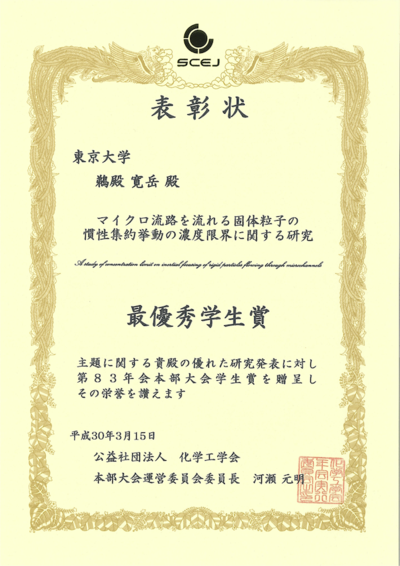TOPICS
- Award-Student
- 2018
Hirotake Udono (D1), Department of Nuclear Engineering and Management, won the Most Excellent Student Award at the 83rd Annual Meeting, SCEJ
On March 15, 2018, Hirotake Udono, Ph.D. candidate at the Department of Nuclear Engineering and Management, won the Most Excellent Student Award at the 83rd Annual Meeting organised by the Society of Chemical Engineering, Japan (SCEJ).
This Meeting is held once every year and aimed at giving researchers and students the opportunities to present their results and ideas on wide varieties of topics about chemical engineering. The students who give an excellent poster presentation are entitled to the Most Excellent Student Award.

<About Awarded Research>
When suspension is driven at high throughput through a microchannel, the particles that are randomly dispersed in the fluid can laterally migrate across streamlines and focus into discrete attractors within the cross-section due to fluid inertia. This inertial focusing is expected to benefit many applications such as separation and enrichment of target particles in fluids. In this study, we numerically investigated the effects of suspension concentration on the focusing behaviour.
The more concentrated the fluid is, the more efficient the particle manipulation becomes. But above an upper limit on the concentration, the distinct focusing behaviour is suggested to break down due to inter-particle hydrodynamic interactions (“steric crowding effects”). Despite this importance of the concentration effects, existing imaging techniques have been limited for the purpose of estimation of the upper bound on the concentration and elucidation of mechanism that brings a breakdown in well-defined focusing behaviour. In this study, by using the DEM-DNS method, a numerical method which can simulate the particle-fluid interactions, we presented experimentally unobtainable insights into the densely crowded microscopic fluid scenes for the first time. Based on comprehensive analysis on hydrodynamic interactions between particles, we estimated the upper limit on the suspension concentration for focusing behaviour and elucidated the mechanism of the steric crowding effects.
<Comments>
Winning the award at the 83rd Annual Meeting was a great honour. I appreciate Mikio Sakai, Associate Professor, for his inspiring guidance and advice. I also thank Hosokawa Powder Technology Foundation for funding this research.

